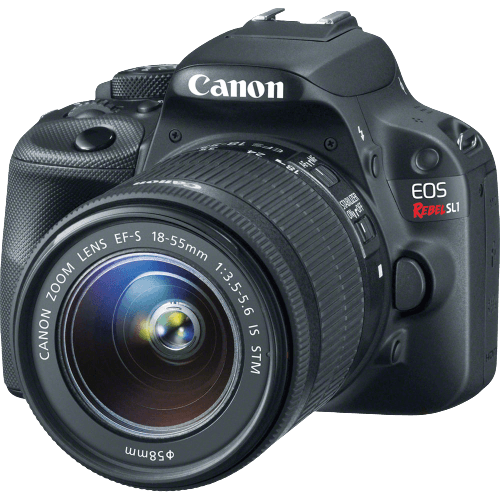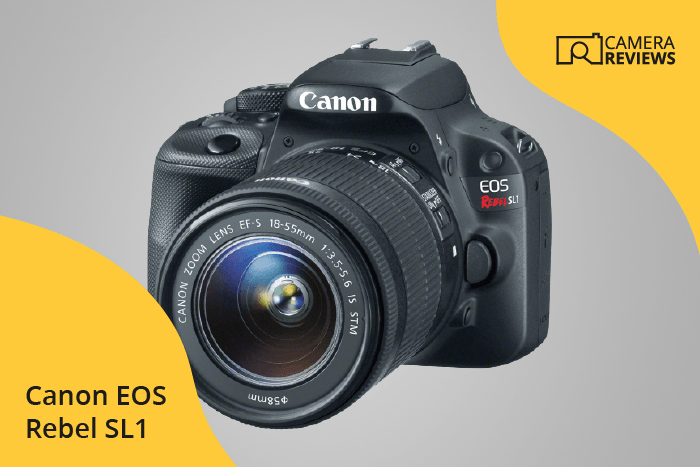Canon EOS Rebel SL1 / 100D Specs and Scores

The Canon EOS Rebel SL1 / 100D receives a score of 43/100. Introduced in 2013, this DSLR camera initially retailed at $650. Measuring 117 x 91 x 69mm and weighing 407g or 0.90lbs, the Rebel SL1 / 100D offers a compact and lightweight design for easy portability. For anyone confused by how Canon names cameras – the Canon EOS Rebel SL1 is the American product name. It is called the 100D in Europe and the EOS Kiss X7 in parts of Asia. For the majority of this article, we’ll refer to it by the American name (Sl1).
Comparing its specifications to today’s market, the Canon EOS Rebel SL1 may not be the most competitive option. However, its compact size and affordable price make it a decent choice for those seeking a budget-friendly DSLR camera.
Canon EOS Rebel SL1 Overview and Optics
The optics of the Canon EOS Rebel SL1 receive a score of 40/100. This camera features 18 megapixels, a shooting speed of 4 frames per second, and a CMOS sensor. It uses the Digic 5 processor and has a DXOMARK score of 63 for the sensor. The sensor size is APS-C, and it has a Canon EF-S lens mount. However, it does not have image stabilization and has an aspect ratio of 3:2.
In today’s market, the Canon EOS Rebel SL1 optics may not be considered outstanding. Competing cameras often have higher megapixel counts, faster shooting speeds, and more advanced processors. Additionally, image stabilization is a desirable feature that the Rebel SL1 lacks. The camera’s APS-C sensor size is common, but larger sensors, such as full-frame, are more sought after for better image quality.
Despite its lower score, the Canon EOS Rebel SL1 can still produce quality images. Its optics may not be cutting-edge, but they are sufficient for casual photography and entry-level users. The camera’s compact size and affordable price point make it an attractive option for beginners seeking a budget DSLR.
Canon EOS Rebel SL1 Video Performance
The Canon Rebel SL1 receives a video score of 43/100. Its maximum video resolution is Full HD, with dimensions of 1920 x 1080 pixels. The camera’s maximum video frame rate is 30fps. Unfortunately, it does not have built-in time-lapse functionality.
In the current market, the video capabilities of the Canon EOS Rebel SL1 are not exceptional. With Full HD resolution and 30fps, the camera is limited compared to other cameras that offer 4K resolution or higher frame rates. The lack of time-lapse functionality is also a disadvantage for users interested in capturing time-lapse videos.
Considering these specifications, the Canon EOS Rebel SL1’s video capabilities are not on par with many modern cameras. Users seeking advanced video features should explore other options.
Canon EOS Rebel SL1 Features and Benefits
The Canon EOS Rebel SL1 receives a feature score of 57/100. With a 3-inch touchscreen, this camera offers convenience in navigating its settings. The screen resolution is 1,040,000 dots, providing a clear display for users. However, the absence of a flip screen may pose limitations for capturing various angles.
Modern camera users often seek connectivity features such as GPS, WiFi, and Bluetooth, which the Canon EOS Rebel SL1 / 100D lacks. This may deter potential buyers who desire seamless file transfers and geotagging capabilities.
Considering the specifications, the Canon EOS Rebel SL1 has its strengths but falls short in meeting some expectations of contemporary photographers. While it may be suitable for those prioritizing a compact design and touchscreen interface, the camera may not satisfy those seeking advanced connectivity options.
Canon EOS Rebel SL1 Storage and Battery
The Canon EOS Rebel SL1 receives a storage and battery score of 21/100. This camera has one memory card slot that accepts SD, SDHC, and SDXC cards. The battery life lasts for 380 shots, which is relatively low compared to other cameras on the market. The battery model is LP-E12, and it does not support USB charging.
While the storage capabilities are sufficient for casual photographers, the battery life is a limiting factor for extended shooting sessions. Users may need to carry extra batteries to avoid running out of power. The lack of USB charging also makes it less convenient for on-the-go charging. Despite these shortcomings, the Canon EOS Rebel SL1 remains a popular option for its other features and performance.
Canon EOS Rebel SL1 / 100D Alternatives
Do you want to know how the Canon EOS Rebel SL1 compares to its competitors? Have a look at the most popular comparisons for this camera below:
- Canon EOS Rebel SL1 vs Rebel SL2
- Canon EOS 6D vs EOS Rebel SL1
- Canon EOS Rebel SL1 vs Nikon D5500
- Canon EOS Rebel SL1 vs EOS Rebel T3i
- Canon EOS Rebel SL1 vs Rebel EOS SL3
- Canon EOS Rebel SL1 vs Sony a6000
Canon EOS Rebel SL1 FAQ
Does the Canon EOS Rebel SL1 Have Built-in Image Stabilization?
The Canon EOS Rebel SL1 does not have built-in image stabilization. However, it supports lenses with optical image stabilization to reduce camera shake and produce sharper images.
Does the Canon EOS Rebel SL1 Support 4K Video Recording?
No, the Canon EOS Rebel SL1 does not support 4K video recording. The maximum video resolution it offers is Full HD 1080p at 30 frames per second.
What Size Sensor Does The Canon EOS Rebel SL1 Have?
The Canon EOS Rebel SL1 features an APS-C sized sensor, which is smaller than full-frame sensors but larger than Micro Four Thirds sensors, offering a good balance between image quality and portability.
Does the Canon EOS Rebel SL1 Have a Dual Memory Card Slot?
No, the Canon EOS Rebel SL1 has a single memory card slot, supporting SD, SDHC, and SDXC cards for storage of photos and videos.
Does the Canon EOS Rebel SL1 Have a Touch Screen?
Yes, the Canon EOS Rebel SL1 features a touch screen, allowing for easy navigation and control of settings, as well as touch focus and touch shutter functionality.
Does the Canon EOS Rebel SL1 Have Wi-Fi and Bluetooth?
The Canon EOS Rebel SL1 does not have built-in Wi-Fi or Bluetooth capabilities. To transfer files wirelessly, you would need to use an Eye-Fi card or a similar solution.
Does the Canon EOS Rebel SL1 Have GPS?
No, the Canon EOS Rebel SL1 does not have GPS functionality built-in. However, you can use an optional GPS receiver accessory to add geotagging capabilities to your images.
Is the Canon EOS Rebel SL1 Weather Sealed?
No, the Canon Rebel SL1 is not weather sealed, so it is not designed to withstand harsh weather conditions such as heavy rain or dust storms. Extra care should be taken when using the camera in adverse conditions.
Does the Canon Rebel SL1 Have a Built-in Flash?
Yes, the Canon Rebel SL1 has a built-in flash for illuminating subjects in low-light situations. It also has a hot shoe for attaching external flash units for more advanced lighting options.

